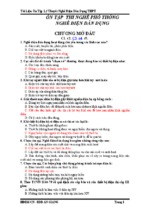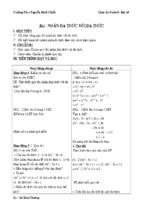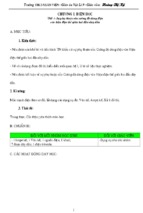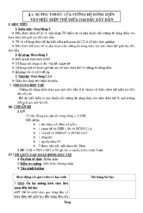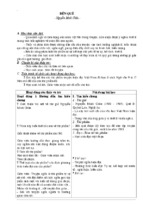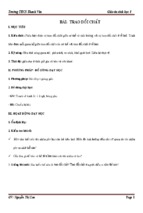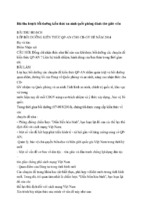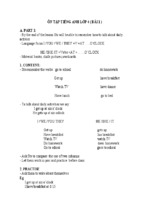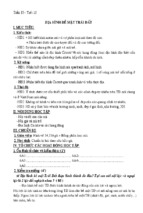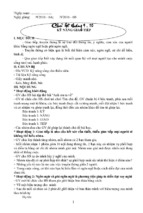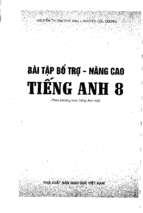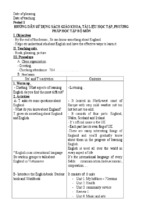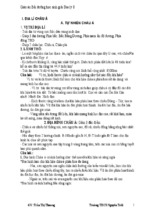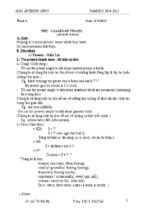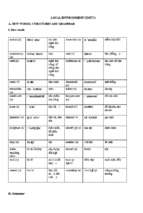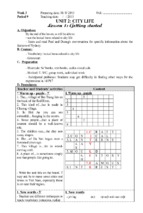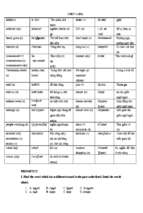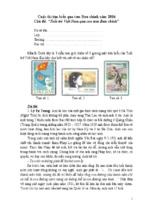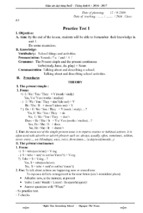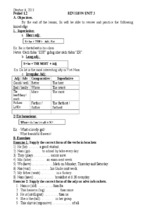Period 1 .
Teacher : Hoang Duc Toan.
date :
/
/ 2011
Revision
To help students review some important grammatical structures whichthey learned in
.
I. Aims:
English 8.
- To make students become more confident before they study English 9.
II. Procedure
1. Warmer
- Greeting.
- Checking attendance.
- Asking for the teaching date.
2. Revision
Students review their old knowledge during the new lesson.
3. New lesson
Teacher’ s activities
a. The verb tenses:
- Present simple:
Students’ activities
- Work in groups of 4 each to
discuss the uses and the forms.
- Each group has one students tell
- T listens and gives more information if necessary: S in front of the class.
+ Vs/es (Third person singular)
S + V (Others left)
* The spelling of ‘-s/es’ forms.
- Work in groups of 4 each to
- Present continuous:
discuss the uses and the forms.
- Each group has one students tell
in front of the class.
- T listens and gives more information if necessary: S
+ is/am/are + Ving
- Work in groups of 4 each to
* The spelling of ‘-ing’ forms.
discuss the uses and the forms.
- Simple past:
- Each group has one students tell
in front of the class.
- T listens and gives more information if necessary: S - Write some irregular verbs.
+ Ved (Regular verbs)
* The spelling of ‘-ed’ forms.
* Irregular verbs:
Buy - Bought
- Work in groups of 4 each to
Make - Made
discuss the uses and the forms.
................
- Each group has one students tell
- Simple future:
in front of the class.
- T listens and gives more information if necessary: S - S + have/has + PII
+ will/shall + V(Infinitive)
- S + have/has + not + PII
* We use shall for I and We.
I haven’t seen him yet.
Have you seen him lately?
-Have/Has + S + PII
Present perfect tense:
I have (I’ve) done my homework.
- Form?
- I’ve live here for 10 years.
- Use?
To talk about something which started in the past and - I’ve lived here since 1998.
continues up to the present.
- We often use “For” and “Since” with the present - Individual work
perfect tense.
+ For: A period of time.
+ Since: A point of time (starting point)
- yet, already, lately, recently, never, just,...
Exercise: Put the verbs in brackets into the Simple
present, present continuous, simple past, simple
future, present perfect tense and then change them
into the negatives and interrogatives:
1. He (watch) TV.
2. She (do) her homework.
- Ss do the exercises given by
3. They (buy) a new car.
teacher.
4. The children (sit) in the classroom.
5. The boys (play) football.
1
Teacher elicits from students the formations of the
indirect speech and the passive form.
Period 2 .
Exercises on Indirect speech:
Change the following sentences into indirect speech:
1. “I have something to show you,” I said to her.
2. “I’m going away tomorrow, mother,” he said.
3. “Does this train stop at York?” asked Bill.
4. “Is a return ticket cheaper than two singles?” said my aunt.
5. “Where is the ticket office?” asked Mrs. Jones.
6. He said, “What is happening?”
7. “When are you coming back?” I asked them.
8. “I’ll come with you as soon as I am ready,” she replied.
9. “Stand up, please!” he said.
10. “You should study harder.” the teacher advised Nam.
11. Peter said to Paul, “Are you working as well as studying?”
12. “Can you get coffee on the train?” said my aunt.
Exercises on the passive voice:
Change the following sentences into the passive voice:
1. They make shoes in that factory.
2. They built that skyscraper in 1934.
3. You must wash your hands before meals.
4. Peter writes a letter.
5. Somebody built the house last year.
6. They speak English in the shop.
7. She can sew three shirts a day.
8. She gave me the box.
9. The students handed in the reports.
10. Steven forgot the book.
4. Consolidation
Teacher retells and emphasizes the structures students have reviewed.
5. Homework
Put the verbs into the correct tense (Simple Past or Past Progressive).
1. While Tom (read) , Amely (watch) a documentary on TV.
2. Marvin (come) home, (switch) on the computer and (check) his emails.
3. The thief (sneak) into the house, (steal) the jewels and (leave) without a trace.
4. Nobody (listen) while the teacher (explain) the tenses.
5. While we (do) a sight-seeing tour, our friends (lie) on the beach.
6. He (wake) up and (look) at his watch.
7. I (jog) in the park, when two squirrels (cross) my way.
8. Robert (fall) off the ladder when he (pick) cherries.
9. Archimedes (discover) the theory of buoyancy while he (take) a bath.
10. When we (travel) around Ireland, we (meet) some very nice people.
_____________________________________________________________
Teacher : Hoang Duc Toan.
date :
/
Unit 1 : A visit from a pen pal
Getting started & listen and read
I. Aims: - Reading the text to understand the details.
Presentation and practice in “wish” to talk about unreal present desires.
II. Procedure
1. Warmer
- Greeting.
- Checking attendance.
- Asking for the teaching date.
2. Revision
2
/ 2011
.
Teacher gets some students to stand in front of the class and tell some important grammatical
problems they learned in English 8.
3. New lesson
Teacher’ s activities
Students’ activities
a. Getting started:
- What activities would you do if a foreign pen pal is - Guess the activities from picture
a) – f) P.6 (Students can express
coming to stay with you for a week?
their own ideas.
- Work in pairs and compare in
a. Going to Hung’s Temple.
groups of 4.
b. Visiting the Literature Temple in Hanoi.
c. Going to Dong Xuan Market or Going
shopping.
d. Visiting the museum.
e. Eating out.
f. Going to the theater.
b. Presentation:
Pre teach:
- Tell the meaning of the new words
I. New words:
in Vietnamese.
+ To correspond [,kɔris'pɔnd] = to write to another. - Repeat in chorus.
+ To be impressed (by): BÞ g©y Ên tîng (bëi)
- Read in individuals.
+ To pray: (Mime)
+ To depend [di'pend] on: Phô thuéc vµo.
+ To keep in touch: Gi÷ mèi liªn l¹c.
- Check the spelling and
pronunciation.
+ A mosque [mɔsk]: Nhµ thê Håi Gi¸o.
- Copy down on the notebooks
- Teacher reads once again
Pre questions:
Set the scene: Razali Maryam is Lan’s pen pal. She
came to stay with Lan last week. You are going to
read a text about Maryam and her visit to Vietnam:
1. Where did Lan take Maryam to?
- Work in groups of 4 to predict the
2. Did Maryam invite Lan to visit her country?
answers to the questions.
II. Listen and read
Presentation text: Listen and Read P.6,7
- Listen following the text.
- Plays the disk.
- Read in individuals to find the
1. Check the prediction
correct answers to the questions.
- Answer key:
1. - Hoan Kiem Lake.
- Ho Chi Minh’s Mausoleum/ the History Museum
and Van Mieu.
- Many beautiful lakes and parks in Hanoi, the - Read the text again then choose
mosque on Hang Luoc Street.
the correct option to complete the
2. Yes, she did.
sentences.
2. Multiple choice: 1-5 p.7,8
3. Grammar note:
- “I wish you had a longer
vacation.”
Model sentence:
- Teacher elicits the model sentence from students:
What did Lan say to Maryam?
- Yes.
I wish you had a longer vacation
*Concept check:
- No.
- Does Lan want Maryam to have a longer vacation?
- No.
- Can Maryam stay longer?
- No
- Can her wish come true now?
- Does the sentence express unreal present or past - Unreal present desire.
desire?
- What tense is used for the verb in the subordinate - The simple past tense.
clause?
Notes: “Wish” in the sentence above is used to
express unreal present desire. The simple past tense is
used in the subordinate clause. For the verb ‘to be’,
“Were” is more often used than “Was”.
S 1+ (WISH) + S2 + V(Simple past tense)
III. Practice
c. Practice:
- T: can’t visit Malaysia.
Repetition drill:
- Ss: I wish I could visit Malaysia.
1. Can’t visit Malaysia
2. Can’t see that film
3. don’t have a trip abroad.
- Students use ‘Wish’ to finish the
3
d. Futher practice:
Teacher gives unreal situations:
second sentence (orally):
1. I wish I knew her address.
1. I want to phone her but I don’t know her address.
2. We’ve lost the way because we don’t have a map.
3. Marie isn’t here now.
2. We wish we had a map.
4. They won’t come with us.
4. We wish they would come with
us.
5. We wish today were a holiday.
5. Today is not a holiday.
3. We wish she were here now
4. Consolidation
Teacher retells and emphasises the structures using ‘Wish’ students have studied.
5. Homework
- Prepare for the next lesson: Unit 1: Speak + Language focus 1.
- Do exercise 7 page 10 (workbook).
4
Period 3 .
2011
.
Teacher : Hoang Duc Toan.
date :
/
/
Unit 1
A visit from a pen pal
Speak + language focus 1
I. Aims: In order to help students practise speaking.
II. Objectives : By the end of the lesson, students will be able to improve the dialogue based on
the provise phrases (P.18)
III. Procedure
1. Warmer
- Greeting.
- Checking attendance.
- Asking for the teaching date.
2. Revision
Jumbled words:
Troicendu = introduce
Derscopron = correspond
Mispres = impress
Daroba = abroad
Answer the questions:
1. Where does Lan’s pen pal come from?
2. How long have they been pen pals?
3. How often do they correspond to each other?
4. When did Maryam come to stay with Lan?
5. Where did Lan take Maryam to?
3. New lesson
Teacher’ s activities
a. Pre speaking:
I. Speaking:
1. Speak a P.8
Ordering:
* Set the scene: “Nga is talking to Maryam. They are
waiting for Lan outside her school.”
- What activities would you do if a foreign pen pal is
coming to stay with you for a week?
- Teacher has students give their answer.
- Teacher elicits the correction from students.
Answer key:
1c – 5b – 4d – 2e – 3a – 6.
b. While speaking:
2. Speak b P.8
Example:
a. Yoko from Tokyo, Japan:
Lan: You must be Yoko – Maryam’s friend.
Yoko: Yes. That’s right. I am.
Lan: Pleased to meet you, Yoko. Let me introduce
myself. I’m Lan’s classmate.
Yoko: Pleased to meet you.
Lan: Are you enjoying your stay in Vietnam?
Yoko: Yes, very much. I’d like Vietnamese people
because they are very friendly. I love old cities in
Vietnam like Hue and Hanoi.
Lan: Is Hanoi different from Tokyo?
Yoko: Yes. The two cities are the same in some ways.
They are both big and busy capital cities.
- Team work.
- Students write their answer on
the notebooks. (Individually)
- Teacher collects some notebooks
and give feedback.
- Teacher gives correct answers.
Students’ activities
- Students read the dialogue silently
and put the dialogue in the correct
order.
- Compare their work in pairs.
- Copy down.
- Students practise the dialogue in
pairs.
- Students take turns to be one of
Maryam’s friends to make similar
dialogues.
5
- Teacher monitors and gives help.
- Teacher has some pairs practise their dialogue before
the class.
II. Language focus 1 P.11
Example exchange:
S1: What did Nga do on the weekend?
S2: She went to the concert – Hanoi singers.
S1: When did she see it?
S2: She saw it on Saturday morning at 8 o’clock.
c. Post Speaking:
III. Practice:
Write it up:
- Practise in pairs.
- Read the information given in the
box, work in pairs to make similar
dialogues.
- Write. Change the dialogue into
narratives. (Individual work)
Example:
a. Yoko is one of Maryam’s friends. She comes
from Tokyo, Japan. Tokyo is the same as
Hanoi capital. It is a big and busy city. Last
week Yoko came to stay with us. We took her
to some tourist attractions like Van Mieu, Ho
Chi Minh’s Mausolem, the History Museum...
She likes.....She loves.....
b. ...
4. Consolidation
Teacher retells and emphasises the aims.
5. Homework
- Prepare for the next lesson: Unit 1: Listen+ Language focus 2, 3.
- Do exercise 1, 2, 3 page 5-7 (workbook).
Period 4 .
Teacher : Hoang Duc Toan.
date :
/
/ 2011
Unit 1
A visit from a pen pal
Listen + language focus 2, 3
I. Aim: Practice in listening skill. Listen and choose the picture and practice the past simple tense with
“wish”.
II. Objectives : By the end of the lesson, students will be able to get the information from the text.
V. Procedure
1. Revision
- Work in groups of 4 each to
Simple past:
- T listens and gives more information if necessary: S discuss the uses and the forms.
- Each group has one students tell
+ Ved (Regular verbs)
in front of the class.
* The spelling of ‘-ed’ forms.
* Irregular verbs:
- Write some irregular verbs.
Buy - Bought…
Make - Made
- How to make “Wh” questions in the simple past?
2. New lesson
Teacher’ s activities
Students’ activities
I. Language focus:
S 1+ (WISH) + S2 + V(Simple past
Language focus 3 P.12
T: How can we use “wish” to express the unreal tense)
present desire?
- Individual work then compare in
- Teacher check with the whole class.
pairs.
Language focus 2 P.12
- Gets students to write about Lan and her friends - Look at the pictures, read the
preparing for a farewell party.
words given in the box and match
1. Lan made a cake.
the verbs with the nouns to
2. Ba hung colourful lamps on the walls of Lan’s room understand what Lan and her
to make it brighter.
friends did to prepare for the party.
6
3. Nga went to the market to buy a bunch of flowers.
4. Nam painted a picture of Hanoi to present Maryam.
Tam and Huong went to the market to buy some fruit.
II. Listening
a. Pre listening:
* Set the scene: “Carol is Tim’s pen pal. She is from
Mexico. She is visiting the USA. Tim suggests doing
something.”
Guessing:
a. Keep off the grass / Don’t walk on the grass.
b. Go by bus / Which bus to take: the 103 bus ur
the bus number 130?
c. Eat in a Mexican restaurant or eat
Hamburgers?
Pre question:
1. Where does Tom suggest doing?
2. How are they going?
3. Does Carol like walking in the park?
- Individual
compare.
work
then
pairs
- Look at the pictures on page 9
and tell what each picture means.
- Predict the answers to the
questions.
- Listen to the disk then find the
answers to the pre questions.
b. While listening:
Checking prediction:
- Listen and write the answer to the
1. going to a restaurant down town.
questions (Short answers)
2. going by bus
3. Yes, she does.
Multiple choice:
- Listen to the disk again and check
a. Keep off the grass.
the correct pictures.
b. Take the bus number 130.
c. Eat hamburgers.
Comprehension questions:
- To a restaurant down town.
- Teacher has students read the questions then plays - By bus.
the disk again.
- beautiful.
1. Where does Tim suggest going?
- To keep off the grass.
2. How are they going?
3. What’s the park like?
- number 130.
4. What does Tim remind Carol to do while they are - hamburgers.
walking in the park?
5. Which bus are they going to take?
6. What are they going to eat?
- Teacher has students give their answers and elicits
the correction from students if necessary.
- Write full answers to 6 questions
III. Practice:
in “While listening” to make a
c. Post listening:
passage about Tim and Carol’s visit
to the down town.
Writing:
Tim suggests going to a restaurant downtown.
They are going by bus. It’s so beautiful with trees,
flowers and a pond in the middle. He reminds her to
keep off the grass. They are going to take the bus
number 130. They are going to eat hamburgers.
3. Consolidation
Teacher retells and emphasises the aims.
4. Homework
- Prepare for the next lesson: Unit 1: Read.
- Do exercise 5, 6 (workbook), look for information about Malaysia.
___________________________________________________________________________
Period 5 .
Teacher : Hoang Duc Toan.
date :
/
/ 2011
Unit 1 : A visit from a pen pal
read
I. Aims : Reading for details about Malaysia, a member of ASEAN.
II. Objectives : By the end of the lesson, students will be able to understand and retell the text.
III. Procedure
1. Revision
7
Chatting:
- Do you remember Maryam?
- Who is she?
- Where is she from?
- Where is Kuala Lumpur?
2. New lesson
Teacher’ s activities
a. Pre reading:
Pre teach:
- to divide [di'vaid]...into: Chia ra
- to separate ['seprət] from: T¸ch ra tõ...
- be separated by
- to comprise [kəm'praiz]: Bao gåm (to consist of)
- compulsory [kəm'pʌlsəri]: b¾t buéc
- a federation [,fedə'rei∫n]: liªn ®oµn
- territory ['terətri] : Vïng l·nh thæ.
Checking vocabulary: R0R.
T/F statements prediction:
1. Malaysia is a country of ASEAN.
2. There are two religions in Malaysia.
3. People speak only Malay in Malaysia.
4. Primary school children learn three language at
school.
5. All secondary school children learn in English.
b. While reading:
T/F statements:
Answer keys:
1. T
4. T
2. F. There are three religions in Malaysia.
3. F. People speak only Malay in Malaysia.
5. F. All secondary school children learn in Malay.
Grid:
5. Capital city: Kuala
1. Area: 329,758 km2
Lumpur
2. Population: over
6. Official religion:
22.000.000
Islam
7. National language:
3. Climate: tropical
Bahasa Malaysia
4. Unit of currency:
8. Compulsory second
Malaysia ringgit
language: English
c. Post reading:
Discussion:
- What do you know about Malaysia?
Write it up
- Group work.
- Teacher – Whole class
Students’ activities
- Tell the meaning of the new words
in Vietnamese.
- Repeat in chorus.
- Read in individuals.
- Check the spelling and
pronunciation.
- Copy down on the notebooks
- Predict the answers to the
questions.
- Read the text about Malaysia then
check and correct the false
statements.
- Read the text in silence then
complete the table. (Read a P.10)
- Read the information they have
found in read a) again then work in
groups of four to talk about
Malaysia.
- Write what they know about
Malaysia. (Individual work)
3. Consolidation
Teacher retells and emphasises the structures using ‘Wish’ students have studied.
4. Homework
- Prepare for the next lesson: Unit 1: Write.
- Do exercise 4 page 7,8 (workbook).
Teacher : Hoang Duc Toan.
date :
/
Unit 1 : A visit from a pen pal
Write
Period 6 .
8
/ 2011
.
I. Aims : Giving students practice in writing a letter to their parents or friends about their visit to
another part of the country or a different country.
II. Objectives : By the end of the lesson, students will be able to write a letter telling about their
trip to their friends or relatives in Viet Nam or in different countries.
V. Procedure
1. Revision
Chatting:
- Have you ever been to another part of our country?
- When did you go?
- Who did you go with?
- How did you go?
Form of a personal letter?
2. New lesson
Teacher’ s activities
I. Pre writing:
* Set the scene: “Imagine you are visiting another part
of Vietnam. Write a letter to your friend or parents.”
Making outline:
First paragraph:
- Where / you now?
- Have a good or terrible journey?
- Travel by...? / How long...?
- When / arrive?
- Who / met / at...?
Second paragraph:
- What / do / the day / arrive?
- On the following days?
- (Visit/take photos/eat/buy souvenirs)
- Meet your friend?
Third paragraph:
- Have a good time?
- How / feel / like / stay?
- (The sights / food / people)
- When / come back?
II. Writing:
- Teacher monitors, takes notes of typical mistakes and
helps if necessary.
Suggested letter:
Dear Mom and Dad,
I’m now on holiday in HCM City. We had a terrible
journey. We went by train. The weather was awful. It
rained all the time. And the train was delayed for
three hours.
So it took 50 hours to travel from HN to HCM City. I
think I will never travel by train again. I was so late
that nobody met me at Saigon Station. I took a taxi to
our uncle’s house. They were so glad to see me.
I was rather tried on the day I arrived. I didn’t do
much for the first two days. On the following days, we
spent most of the time visiting Dam Sen Park...
I’m having a good time in HCM City now. I enjoy the
foods because they are delicious. I like the sights
because they are beautiful. I love the people, too.
They are helpful and friendly. However, I miss you
both and I wish you were here now. If you were here
we would have more fun. I’ll come back on 25 th
September and please pick me up at the Noi Bai
- Teacher – Students
- Group work
- Opening: Dear...,
- Body of the letter
+ First paragraph
+ Second paragraph
+ Third paragraph
- Closing: Yours...
Students’ activities
- Students work in pairs, ask and
answer questions using the
information given above to tell
each other about their visit.
* Example:
S1: Where are you now?
S2: I’m on holiday in Ho Chi Minh
City.
S1: Did you have a good journey?
S2: No. The weather was awfully
bad on the day I went.
......
- Write their letter (Individual
work)
- Swap their writing and correct any
9
Airport at...
mistakes if necessary.
Love
III. Post writing:
- Writes typical mistakes on the board and elicits the
correction from students.
- Gets some students to read their letters before the
class.
3. Consolidation
Teacher retells and emphasises the way to write a personal letter.
4. Homework
- Prepare for the next lesson: Unit 2: Getting started + Listen and read.
- Do exercise 8 P.11 WB.
Period 7 .
Teacher : Hoang Duc Toan.
date :
/
/ 2011
Unit 2: clothing
Getting started & listen and read
I. Aims: Presenting vocabulary to talk about the development of the “ao dai”
II. Objectives: By the end of the lesson, students will be able to know about the traditional clothes
of some nations and Ao Dai in Vietnam.
V. Procedure
1. New lesson
Teacher’ s activities
Students’ activities
I. Getting started:
- Elicits the answers from students.
- Look at the pictures of people
a. She comes from Japan.
wearing the national dresses of
b. She comes from Vietnam.
their country (Pictures a-f) on page
c. He comes from Scotland.
12 and describe where each person
d. She comes from India.
comes from.
e. He comes from the USA.
f. She comes from Arabia (Saudi).
II. Presentation:
1. New words:
Forming the words (revision):
To design
(N)Designer / design
To wear
Simple past/PII: wore/worn
To symbolize
Noun: Symbol
Tradition
Adj / Adv: Traditional(ly)
Frequently
Adj: Frequent
Poem
Noun: Poet / Poettry
Modern
Verb: Modernize
- Tells students any words that they can’t change the
form.
New words:
- To take inspiration [,inspə'rei∫n] from: LÊy c¶m
høng tõ...
- Loose > < tight
- Minority [mai'nɔriti]: ThiÓu sè > < Majority
[mə'dʒɔriti]
- Velvet ['velvit]: Nhung
- Stripes: V¹ch kÎ
- a long silk tunic ['tju:nik]: ¸o lôa dµi.
Checking Vocabulary: R0R
- Set the scene: You are going to read the text about
the traditional dress of Vietnam – The ao dai.
2. Pre questions:
1. What’s our national dress?
2. What’s it made from? – Silk or velvet or both?
3. Who often wears it?
4. When do they often wear it?
3. Listen and Read P.13
- Plays the disk.
10
- Forming the words.
- individual work then discuss in
groups of 4 each.
- Tell the meaning of the new words
in Vietnamese.
- Repeat in chorus.
- Read in individuals.
- Check the spelling and
pronunciation.
- Copy down on the notebooks
- Work in groups of 4 to predict the
answers to the questions.
- Listen following the text.
- Read in individuals to find the
correct answers to the questions.
.
- Answer key:
1. The ao dai is.
2. It’s either made from silk or velvet.
3. Women often wear it.
4. They often wear it on special occasions.
III. Practice:
1. Complete the sentences:
- Listen&Read a P.14
- Checks the answers.
1. poems, songs and novels.
2. traditional dress of Vietnamese women.
3. to wear modern clothing at work.
4. lines of poetry on it.
5. traditional designs and symbols like suns, stars,
crosses and stripes to velvet.
2. Comprehension questions:
- Listen&Read b P.14
1. By traditional, men and women used to wear the ao
dai.
2. The majority of Vietnamese women prefer to wear
the ao dai at work because it’s more convenient.
3. To modernize the ao dai, fashion designers have
printed lines of poetry on it. And they have added
traditional designs and symbols like suns, stars,
cresses and stripes to velvet.
IV. Futher practice:
Discussion:
1. When / where / why women in Vietnam like
wearing the ao dai?
2. The changes to the traditional ao dai.
- Individual work.
- Share answers with their partners.
- Pair work.
- Work in groups of four each to
talk about the ao dai.
2. Consolidation
Teacher retells and emphasises the structures using ‘Wish’ students have studied.
3. Homework
- Prepare for the next lesson: Unit 2 : Speak.
- Write some sentences about the Ao dai.
Period 8 .
Teacher : Hoang Duc Toan.
date :
/
/ 2011
Unit 2: clothing
Speak
I. Aims: Giving students more practice in talking about the clothes they like to wear on different
occasions.
II. Objectives : By the end of the lesson, students will be able to talk about their habits or interests
in different types of clothes.
III. Procedure
1. Revision
Noughts and crosses: Talking about the ao dai.
1. What is our traditional dress?
2. What is it made of?
3. What is the ao dai described as?
4. Who used to wear the ao dai by traditional?
5. Why do the majority of Vietnamese women prefer
to wear modern clothing at work?
6. What have fashion designers done to modernize
the ao dai?
7. On what day do you have to wear school uniform?
8. What do your teachers often wear on Teachers’
Day?
9. What colour is your school uniform?
2. New lesson
Teacher’ s activities
- Team work.
1
2
3
4
5
6
7
8
9
Students’ activities
11
a. Pre speaking:
I. New words:
Pre teach:
- Teacher uses the words of different clothes on
page 17 (or other clothes Ss are wearing) to teach
these words:
- Plaid [plæd]: KÎ ca r«
- Sleeve [sli:v]: Tay ¸o - Sleeveless: Céc tay
- Fade ['feid]: B¹c mµu
- Plain [plein]: tr¬n (Kh«ng cã hoa)
- Casual ['kæʒjuəl]: B×nh thêng, kh«ng trÞnh
träng.
Checking: What and where.
II. Speaking:
1. Matching:
- Speak a) P.15
a. a colourful
T-shirt
d. a plain suit
b. a sleeved
sweeter
e. faded jeans
- Read the phrases and try to guess the
meaning of each phrase.
c. a striped shirt - Do the matching.
- Repeat the phrases in chorus.
f. a shotrsleeved blouse
Read the questions on page 14, then
i. blue shorts -work
in pairs to add three more
questions.
g. baggy pants
h. a plaid skirt
b. While speaking:
2. Questions:
1. What do you usually wear on the weekend?
Why do you usually wear these clothes?
2. What is your favorite type of clothing? Why?
3. On what day do you wear school uniform?
What colour is it?
4. What type of clothing do you wear on Tet / your
birthday? What would you wear to a party?
3. Survey:
- Speak b P.15
Clothes
Favorit
for
Casual
School
Nam
e
special
clothes clothes uniform occasion
e
s
Wear it
every
Jeans
A short
day
Short
and a
sleeved
except
baggy
long
blouse/
for
pants
sleeved
baggy
Sunday. blouse.
and
Hoa
pants
Comfort
short
Look
cool,
able,
sleeved
stronger
comforta blouse
dark
in these
ble
blue
clothes
and
white
c. Post Speaking:
Feedback:
Lan: Hoa said she often wore a short-sleeved
blouse and baggy pants. She said she like them
because they were cool and comfortable. She said
her favorite clothes were short baggy pants and
short sleeved blouse. She said she wore school
uniform every day except for Sunday. She said it
was comfortable and it had dark blue and white...
3. Consolidation
Teacher retells and emphasises the aims.
4. Homework
- Prepare for the next lesson: Unit 2: Listen.
12
- Tell the meaning of the new words in
Vietnamese.
- Repeat in chorus.
- Read in individuals.
Check
the
spelling
and
pronunciation.
- Copy down on the notebooks
- Use the given questions to make a
survey.
- Ask 1 or 2 of their classmates to get
information to complete the table.
- Students tell their class what they
have interviewed.
- Do exercise 1,2 page 12-14 (workbook).
Period 9 .
Teacher : Hoang Duc Toan.
date :
/
/ 2011
Unit 2 : clothing
listen
I. Aims : Giving students practice in listening for details and describing people.
II. Objectives : By the end of the lesson, students will be able to describe others. (clothes, age,
hair)
V. Procedure
1. Revision
Net work:
- Group work of four.
- Discuss and write the names of
clothes.
- Some students take turns to read
aloud the word they have, others
listen and add the words they don’t
have to their list.
2. New lesson
Teacher’ s activities
a. Pre listening:
Question and answer:
* Suggested questions:
1. What do you call these clothes in English?
2. What kind of blouse is it?
3. Are these shoes or sandals?
a. A. pants B. blue shorts
C. a skirt
b. A. a long, white sleeved blouse
B. a short, pink sleeved blouse
C. a short, white sleeved blouse
c. A. sandals B. boots
C. brown shoes
Students’ activities
- Look at the pictures (Listen a-c
P.16), ask and answer questions
about the clothes or shoes...
- Repeat the phrases in chorus.
- Look at the pictures about
different types of clothes (P.16) the
listen to the teacher’s reading,
write the order of the pictures as
they hear.
Ordering:
Teacher reads:
1. sandals
2. a short, pink sleeved blouse
3. shorts
4. a long sleeved blouse
5. boots
Keys:
1. c)A 2. b)B 3. a)B
4. b)A
5. c)B
Set the scene: “Marry, a three-year-old girl, is
getting lost. Her father is looking for her. Listen to the
announcement and put a tick beneath the pictures of - Listen to the disk then put a tick
beneath the pictures of the clothes,
what she is weearing.”
shoes, sandals or boots Mary is
wearing.
b. While listening:
Listen P.16:
- Listen to the disk again and check
- Plays the disk.
- T has students give their answers and elicits the the correct pictures.
correction from them if necessary.
- Take notes of Mary’s age, hair
* Answer key:
and the thing she may be carrying.
a. B – shorts
b. C - a short white sleeved blouse
c. C – brown shoes
- Plays the disk again
- Work in pairs to ask and answer
Keys:
questions about Mary.
- Age: 3
13
- Hair: Short, dark hair
- The thing: a doll
c. Post listening:
Comprehension question:
1. How old is Mary? (3)
2. What color is her hair?(short, dark hair)
- Work with your partner to make a
3. What is she wearing?
similar dialogue to describe him
She’s wearing a short sleeved blouse.
She’s wearing blue shorts and she’s wearing (her). (age, height, hair, clothes)
brown shoes.
4. What may she be carrying? (a doll)
Role play:
- Teacher: “Imagine your brother (sister) went
shopping with you in a department store. You have
lost him (her). Now you are at the information desk.”
3. Consolidation: Teacher retells and emphasises the aims.
4. Homework :Prepare for the next lesson: Unit 2: Read.
Period 10 .
Teacher : Hoang Duc Toan.
date :
/
/ 2011
Unit 2 : clothing : read
I. Aims: Giving students practice in reading for details.
II. Objectives: By the end of the lesson, students will be able to tell their friends about the history
of jeans.
III. Procedure
1. Revision
Network:
- Group work of four.
- Discuss and write the names of
clothes.
- Some students take turns to read
aloud the word they have, others
listen and add the words they don’t
have to their list.
2. New lesson
Teacher’ s activities
a. Pre reading:
I. New words:
Pre teach:
- not easy = hard
- to name after sombody: §Æt tªn
- to wear [weə] out: mßn ®i
- to embroider [im'brɔidə]: thªu
Checking vocabulary: Slap the board.
II. Reading:
Set the scene: T: (use the picture of students (P.17):
- What kinds of trousers are these students wearing?
- Are they tight or loose jeans?
Pre questions:
1.What was jean cloth made from?
2. Who gave the name “jean” to this material?
14
Students’ activities
- Tell the meaning of the new words
in Vietnamese.
- Repeat in chorus.
- Read in individuals.
- Check the spelling and
pronunciation.
- Copy down on the notebooks
- Look at the pictures then answer
the questions.
- Predict the answers to the
questions.
3. When did jeans appear for the first time and where?
b. While reading:
Checking predition:
1. from cotton
2. Sailors from Genoa in Italy did.
3. In the 18th century in Europe.
Gap fill:
- Read a) P.17
1. In the 18th century, jean cloth
2. In the 1960s, students
3. In the 1970s, cheaper
4. In the 1980s, fashion.
5. In the 1990s, sale
- Read the text about the history of
jeans and find the answers to the
pre questions.
- Read the text again then complete
the sentences.
Comprehension questions:
- Work in pairs to answer the
- Read b) P.18
questions.
1. It comes from a kind of material that was made in
Europe.
2. They were embroidered jeans, painted jeans.
3. Because jeans became cheaper.
4. Because many famous designers started making
their own styles of jeans, with their own labels on
them.
5. Because the worldwide economic situation got
worse.
c. Post reading:
Chain games:
1. The word “jeans” comes from a kind of material
that was made in Europe.
2. The 1990s’ fashions were jeans.
3. In the 1970s, more and more people began wearing
jeans because they became cheaper.
4. Jeans, at last, became high fashion clothing in the
1980s when famous designers started making their
own styles of jeans with their own labels on them.
5. The sale of jeans stopped going up because the
worldwide economic situation got worse.
- Work in groups of four, take turns
to tell about jeans. (Use the
answers to the questions in “Read
b)” P.18.
3. Consolidation
Teacher gets some advanced students to translate the text in to Vietnamese.
4. Homework
- Prepare for the next lesson: Unit 2: Write.
________________________________________________________________________
Period 11 .
Teacher : Hoang Duc Toan.
date :
/
/ 2011
Unit 2 : clothing
Write
I. Aims : - Presenting a written argument.
- Giving students practice in writing their own argument about students’ uniform.
II. Objectives : By the end of the lesson, students will be able to write their own argument about
students’ uniform.
III. Procedure
1. Revision
Chatting:
- Teacher – Students
- Do you like wearing jeans?
- Students give reasons for their
- Why? / Why not?
choice.
- Teacher uses this situation to lead Ss to the new
lesson.
15
2. New lesson
- Equal ['i:kwəl]: C«ng b»ng
- Practical ['præktikl]: thùc tiÔn
Checking: R0R
2. Presenting an argument:
- Teacher checks students’ understanding:
a. How many parts does an argument have?
b. What are they?
c. What do the writer write in each part?
(I think.../ My
Firstly
opinion is...)
Secondly
Therefore / In
Topic
conclusion
sentence / Point
Finally
of view
Reading the model:
Questions:
1. What does the writer want to persuade readers?
2. How many reasons does the writer give?
Keys:
1. He wants to persuade readers that it’s
necessary for secondary school students to
wear uniform.
2. He gives 3 reasons. Firstly... Secondly...
Thirly...
b. While writing:
- Teacher monitors, takes notes of typical mistakes and
helps if necessary.
Suggested answer:
My opinion is that high school students should wear
casual clothes.
Firstly, wearing casual clothes makes Ss feel more
comfortable. They don’t feel constrained to wear
uniform they don’t like.
Secondly, wearing casual clothes gives students
freedom of choice. They have the right to choose
sizes, colors, and fashions of clothes that they love.
Finally, casual clothes make school more colorful and
lovely. Students feel self-confident when they are in
their favorite clothes.
In conclusion, students, particularly high school
students should wear casual clothes. Wearing casual
clothes is convenient, comfortable and fun.
c. Post writing:
Correction:
- Writes typical mistakes on the board and elicits the
correction from students.
- Gets some students to read their arguments before
the class.
- Students read the form of an
argument given in table 1 P.18
- Read the topic and outline A, then
read the passage again and answer
the questions given by teacher.
- Read outline b) carefully then
work in pairs or in groups to write
to support the arhument that high
school students should wear casual
clothes. (Read 6b P.19)
- Swap their writing and correct any
mistakes if necessary.
3. Consolidation
Teacher retells and emphasises the way to write an argument.
4. Homework
- Prepare for the next lesson: Unit 2: Language focus.
16
Period 12 .
Teacher : Hoang Duc Toan.
date :
/
/ 2011
Unit 2: clothing
Language focus
I. Aims : Giving students more practice in asking for and giving information using the present perfect
and simple past.
- Revision and further practice in the passive form with “can/should/might/have to”.
II. Objectives : By the end of the lesson, students will be able to get the aims well.
III. Procedure
1. Revision
Correcting homework:
- Gets a student to read his/her argument in front of - Reads the argument.
the class.
- Listen and make comment on it. Give the student
mark.
2. New lesson
Teacher’ s activities
The present perfect:
- T uses the dialogue in language focus 1 P.19 to help
Ss revise the use of the present perfect:
1. Present perfect with “since” and “for” and
“recently, how long...”:
- Since: a point of time
- For: a period of time
- Both “Since” and “For” can be used to answer the
question “How long have/has + PII”
- Recently: Indicate an incomplete period of time.
- How long: Ask a period of time of an action.
- When: Ask a start of time of an action.
2. The difference between the Simple past and the
Present perfect.
Practice:
Language focus 1 P.20
Substitution table:
- T has some pairs practise their dialogues
before the class.
Language focus 2 P.20 (Yet/Already)
Matching:
See Giac Lam Pagoda
Visit Reunification Hall
Go to the zoo and
Go to Dam Sen
Botanical Garderns
Amusement Park
Eat Vietnamese food
Find someone who has already...
Example Exchange:
You: Have you seen Giac Lam pagoda yet?
S1: Yes, I’ve already seen it.
You: Have you eaten Chinese food?
S1: No, I haven.
...
- T has some pairs practise before the class.
Students’ activities
- Work in groups of 4 each to
discuss the uses and the forms.
- Each group has one students tell
in front of the class.
- Write some irregular verbs.
- Read the information given in the
box, work in pairs to make similar
dialogues.
- Read the dialogue in pairs, then
make similar dialogues using the
information from the substitution
table P.20
- Match th verbs with the words or
phrases.
- Get out of their seats and asks two
of their classmates if they have
already done or haven’t done
something yet.
- Read the example carefully.
- Read the words in the box (P.20)
the find suitable verb that can go
with each word.
Language focus 3
- Elicits and focuses on the difference between the - Choose the number.
17
present perfect and the simple past (Have you - Make up similar dialogue with the
word given by teacher.
seen...?/When did you see...?)
* Noughts and crosses:
- Divides class in to 2 teams.
- Read the word.
1. Comic
2. Computer
3. Supermarket
4. Volleyball
5. Singapore
6. Movies
7. Elephant
8. Hue
9. Durian
* Example:
T says: “Comic”
S1: Have you ever read a comic?
S2: Yes, I have/No, I haven’t.
The passive form:
Revision:
- Read the examples given in
Language focus 4, 5 P.21 carefully.
- Do the exercises orally.
- Write on their notebooks.
Model sentence:
This exercise must be done carefully.
Model: S + modal verbs + be + PII
Period 13 .
Practice:
- Language focus 4, 5 P.21
- T has students give their answer and does direct
correction if necessary.
3. Consolidation
Teacher retells and emphasises the aims.
Written test (15 minutes)
Use the given words to rewrite each of the following sentences in such a way that it means
exactly the same as the sentence given:
1. I last saw him five years ago. (I haven’t............)
2. It is a pity that he didn’t tell the police the truth. (He wishes……)
3. People used to call him “FAT”. (He..........)
4. It’s a pity I don’t know how to make a cake. (If only............)
5. It’s a pity he didn’t study hard. (He wishes.............)
______________________________________________________________________
Teacher : Hoang Duc Toan.
date :
/
/ 2011
Written test 45’’
A. Aims : Nh»m kiÓm tra kiÕn thøc ng«n ng÷, c¸c kü n¨ng c¬ b¶n, kh¶ n¨ng tiÕp thu c¸c bµi häc cña
häc sinh.
- Gióp ph©n lo¹i häc sinh. Tõ ®ã gi¸o viªn cã biÖn ph¸p gi¶ng d¹y, gióp ®ì thÝch hîp.
The content of the test
I. Listen to a passage then check if each of the following sentences is true or false:
1. Alexander G.Bell was born in the USA.
2. He work with deaf-mute patients in a hospital in Boston.
3. Thomas Watson was Bell’s assistant.
4. Bell invented the telephone.
II. Rewrite each of the sentences below in such a way that it means exactly the same as the
sentence printed before. Begin the sentences with the words or phrase given:
1. Henry always went swimming after school last year.
- Henry used........................................................................................
18
.
2. We have studied English for five years.
- We started..............................................................................................
3. It’s a pity Tom is sick today.
- If only.............................................................................................
4. They have postponed the concert.
- The concert.......................................................................................
5. He hasn’t seen the younger son for three weeks.
- The younger son.................................................................................
6. The manager must sign the cheque.
- The cheque........................................................................................
III. Put the verbs in brackets into the correct form:
1. He (buy) this car five years ago.
2. I (not write) to her since she left school.
3. My mother used (go) to school on foot.
4. Henry gets used (eat) at 8 p.m.
5. Maryam has decided (stay) for another week.
6. It’s time we (catch) the bus.
IV. Choose and circle on the letter A, B, C or D before word or phrase which completes each of
the sentences below the best:
1. Has he............here since he left school?
A. working
B. work
C. worked
D. works
2. Are those jeans..............in China?
A. produced
B. producing
C. produces
D. produce
3. Today young generation is still fond............wearing jeans.
A. in
B. of
C. at
D. on
4. The material is different....................that of the old days.
A. to
B. with
C. from
D. at
5. Some scientists believe that life might..............on another planet.
A. be found
B. found
C. have found D. find
6. Jean cloth was...............made from cotton in the USA.
A. completion B. complete
C. completed D. completely
7. The man decided..................in a hotel on the side of the lake.
A. not staying B. not to stay C. not stay
D. to stay not
8. This shirt.................carefully before using.
A. must have washed
B. must wash
C. must have wash
D. must be washed
Period 14 .
Teacher : Hoang Duc Toan.
check the test
date :
/
/ 2011
A. Aims
- Nh»m ®¸nh gi¸ møc ®é lµm bµi cña häc sinh.
- Gióp häc sinh nhËn ra vµ söa ch÷a nh÷ng lçi sai thêng m¾c ph¶i ®Ó lÇn sau kh«ng lÆp l¹i nh÷ng
lçi sai ®ã.
- T×m ra nh÷ng häc sinh yÕ vÒ c¸c kü n¨ng nµo ®Ó tõ ®ã gi¸o viªn cã biÖn ph¸p gióp ®ì thÝch hîp.
- Gióp häc sinh häc tËp nh÷ng c¸ch tr×nh bµy bµi kiÓm tra s¹ch sÏ, khoa häc cña b¹n m×nh
B. Procedure
1. New lesson
- NhËn xÐt chung vÒ bµi kiÓm tra:
- §a ra c¸c lçi sai tiªu biÓu mµ nhiÒu häc sinh m¾c ph¶i:
+ Kü n¨ng viÕt cßn h¹n chÕ.
+ Grammar mistakes: Bµi chia ®éng tõ cßn nhiÒu lçi, lçi khi vÕt c©u bÞ ®éng,...
+ Spelling: ThiÕu dÊu c©u, ®Çu c©u kh«ng viÕt hoa, kho¶ng c¸ch gi÷a c¸c tõ trong c©u qu¸ liÒn
nhau,...
Ch÷a bµi kiÓm tra:
Answer keys:
19
I. 2 M. Give 0.5 mark for each correct sentence:
1F
2F
3T
4T
Transcript:
On March 3, 1874, Alexander Graham Bell was born in Edinburgh. He was a Scotman
although he later emigrated, first to Canada and then to the USA in the 1870s. In America, he work
with deaf-mutes at Boston University. Soon, Bell started experimenting with ways of transmitting
speech over a long distance. This led to the invention of the telephone.
Bell and his assistant, Thomas Watson, conducted many experiments and finally came up
with a device which they first introduced in 1876. Bell said on the telephone: “Mr.Watson, come here. I
want you”. This was the first telephone message.
II. 3 M. Give 0.5 mark for each correct sentence:
1. Henry used to go swimming after school last year.
2. We started studying English five years ago.
3. If only Tom were not sick today.
4. The concert has been postponed.
5. The younger son hasn’t been seen for three weeks.
6. The cheque must be signed by the manager.
III. 3 M. Give 0.5 mark for each correct verb:
1. bought
2. haven’t written
3. to go
4. to eating
5. to stay
6. caught
IV. 2 M. Give 0.25 mark for each correct answer:
Period 15 .
1C
2D
3C
4C
5A
6D
7B
8D
Teacher : Hoang Duc Toan.
date :
/
/ 2011
Unit 3 : A trip to the countryside
Getting started + listen and read
I. Aims : Reading the text about a trip to the countryside to understand the details and practicing
countryside vocabulary.
II. Objectives : By the end of the lesson, students will be able to get the aims well.
III. Procedure
1. Revision
In the new lesson.
2. New lesson
Teacher’ s activities
Chatting: (Getting started)
- Do you live in the countryside?
- Do you like living in the countryside?
- What activities do you see or do in the countryside?
a. Presentation:
Pre teach:
- Banyan tree: C©y ®a
- A shrine: MiÕu thê, ®iÖn thê.
- Hero: Anh hïng
- Entrance: Lèi vµo, cæng vµo.
- Bamboo forest: Rõng tre.
Checking: What and where.
Set the scene: “You are going to read the text about
Liz’ trip to Ba’s village”.
T/F statement prediction:
- Listen and Read a) P.23
Presentation text:
Students’ activities
- Teacher – Students.
- Tell the meaning of the new words
in Vietnamese.
- Repeat in chorus.
- Read in individuals.
- Check the spelling and
pronunciation.
- Copy down on the notebooks
- Read the statements on page 23
and predict if they are true or false.
(Pairworks)
- Listen to the disk and read the
20
- Xem thêm -

